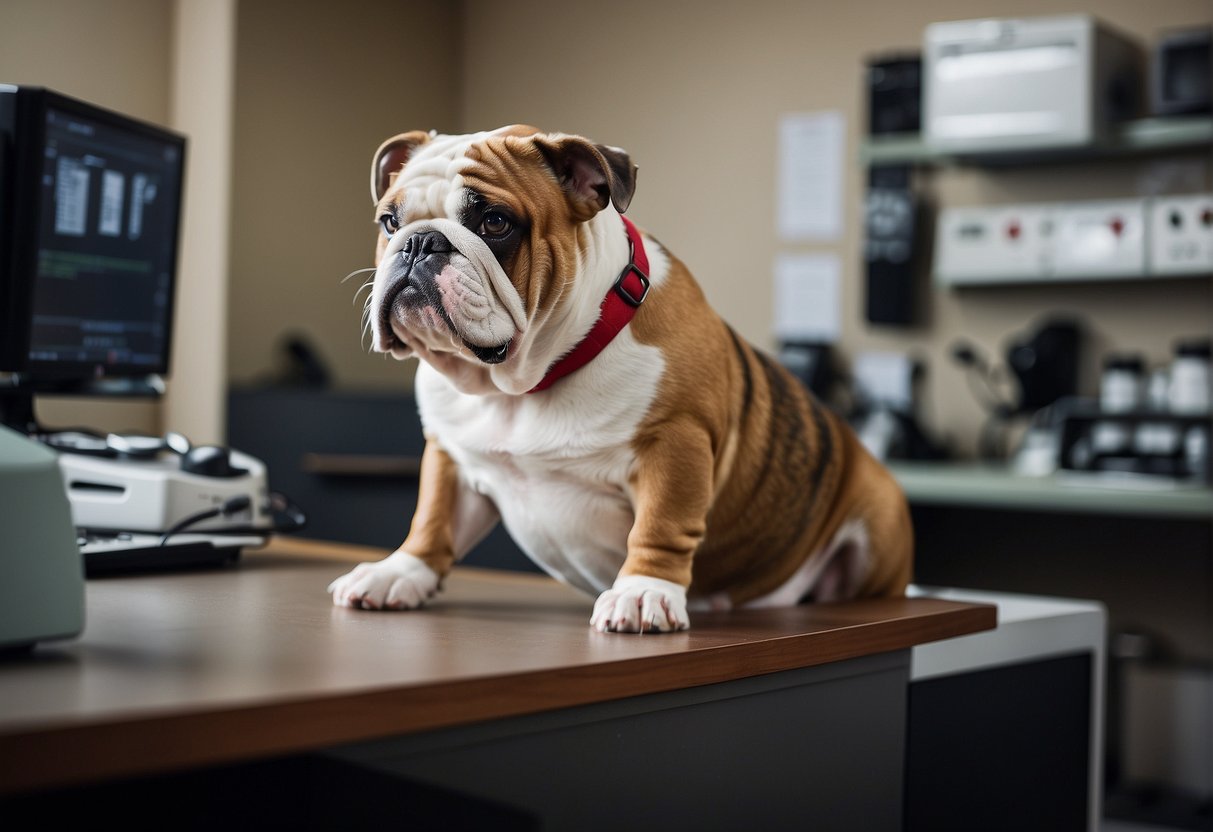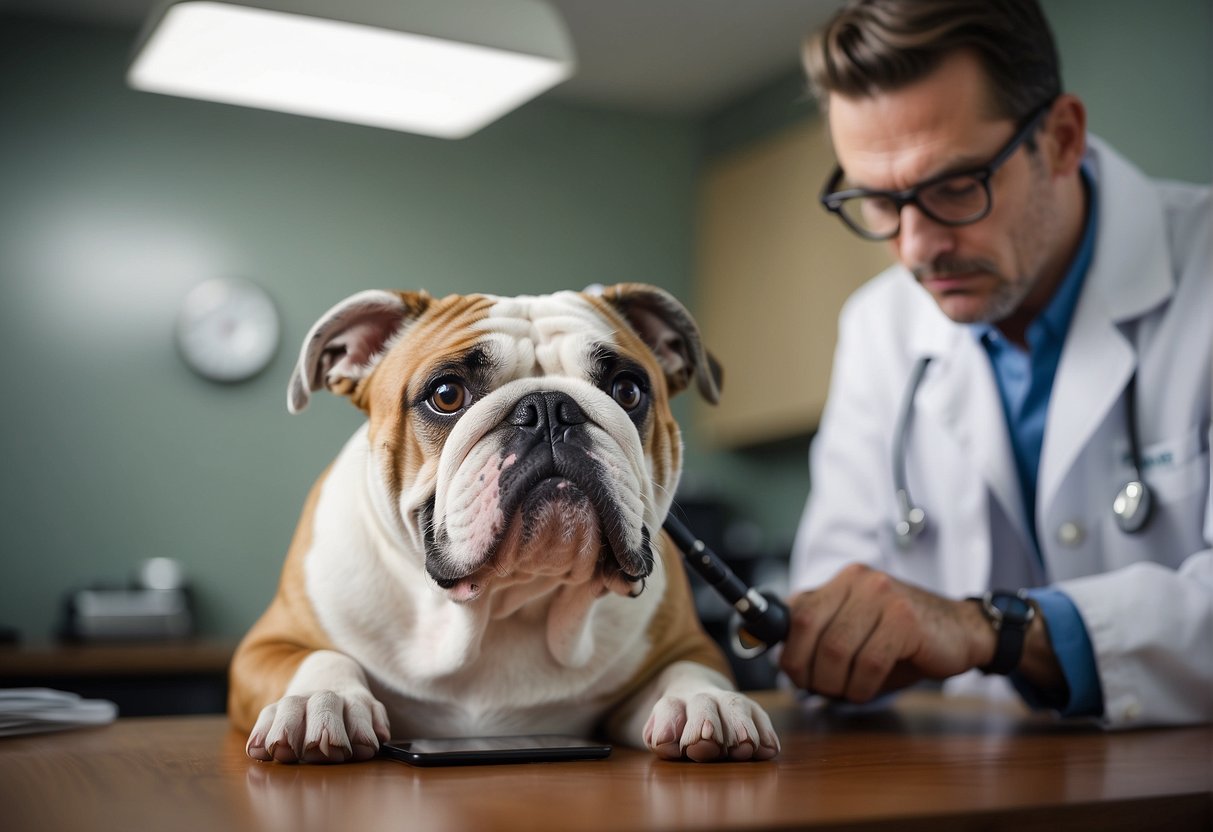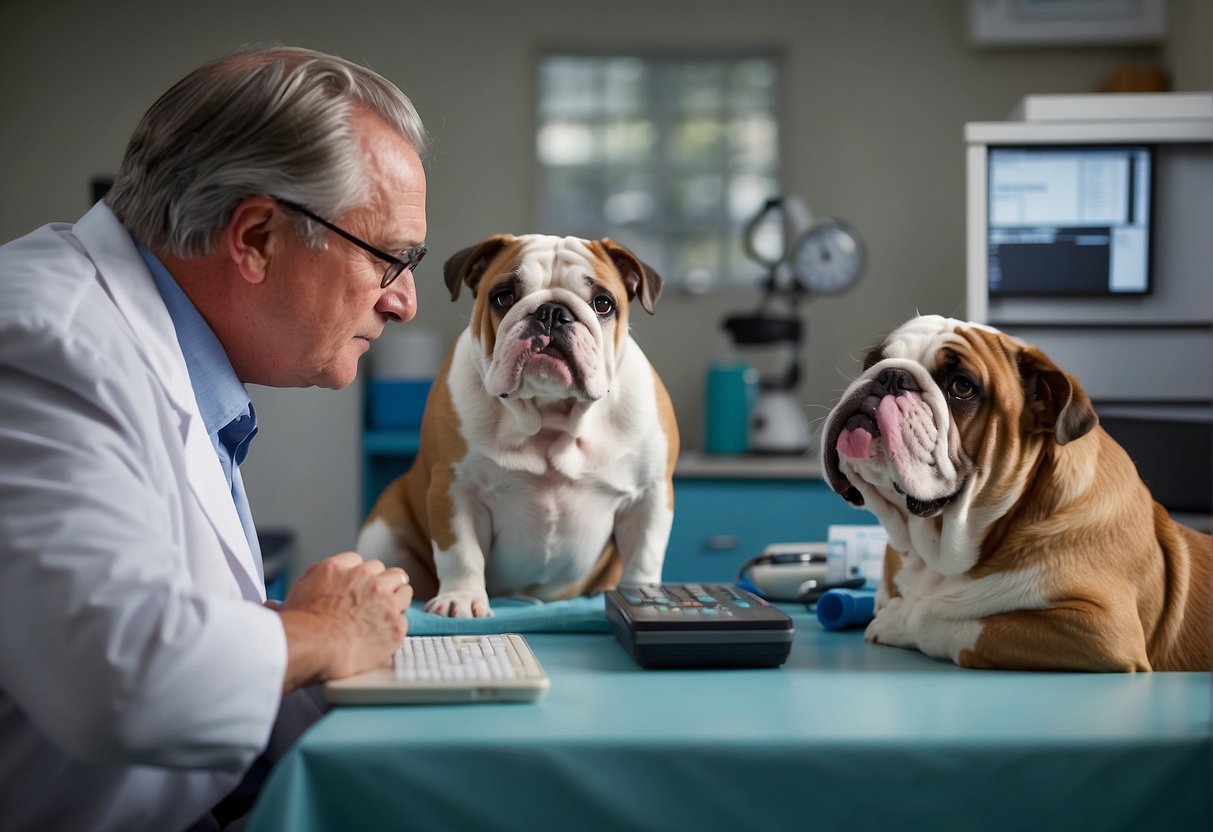Progressive Retinal Atrophy (PRA) is a group of genetic disorders that affect the photoreceptors in the eyes of dogs, often leading to blindness.
English Bulldogs, among other breeds, are susceptible to this condition.
It is crucial for English Bulldog owners to understand PRA’s implications and the importance of early detection to manage the disease effectively.
Knowledge about PRA and the specifics of how it can impact English Bulldogs helps pet owners seek timely veterinary care, potentially prolonging their dog’s quality of life.

Early detection of Progressive Retinal Atrophy in English Bulldogs can be challenging because the early stages of the disease often go unnoticed by pet owners.
Since PRA is a non-painful condition, dogs typically adapt to gradual vision loss until it becomes severe.
Owners might observe hesitancy in their dog’s movements in unfamiliar or dimly lit environments as an initial sign of PRA.
Regular eye examinations by a veterinarian can help detect the onset of PRA before significant vision impairment occurs.
Once diagnosed with PRA, management becomes a key component for English Bulldogs to navigate their changing vision.
While there is no cure for PRA, adjustments to the dog’s environment can aid in their comfort and safety.
Ramps, consistent home layouts, and added lighting can help an affected Bulldog maintain independence.
Additionally, owners can explore genetic testing options to make informed decisions about breeding to prevent the perpetuation of PRA in future generations.
Understanding Canine Progressive Retinal Atrophy

Progressive Retinal Atrophy (PRA) is a group of genetic disorders that involve the gradual deterioration of the retina in dogs.
This condition often leads to blindness over time and affects a wide range of breeds, including English Bulldogs.
At the core of the retina are photoreceptor cells, which include rods and cones.
Rods are responsible for vision in low light, while cones facilitate color vision and detail.
In PRA, the photoreceptors begin to degenerate, impairing the dog’s vision.
This condition is autosomal recessive, meaning a dog must inherit the defective gene from both parents to develop PRA.
Since it is hereditary, some breeds are more predisposed than others, such as Cocker Spaniels, Poodles, Labrador Retrievers, and Irish Setters, but it can occur in English Bulldogs as well.
Early detection is critical for managing PRA.
Owners may notice signs like difficulty with vision in dim lighting or hesitation in unfamiliar environments.
As the disease progresses, a dog may eventually become completely blind.
| Key Components of PRA | Description |
|---|---|
| Photoreceptors | Rods and cones affected by degeneration |
| Hereditary Nature | Autosomal recessive genetic predisposition |
| Symptoms | Diminished vision, leading to blindness |
| Affected Breeds | High prevalence in certain dog breeds |
Although retinal atrophy is irreversible, understanding PRA can help owners provide the best possible care for their pets, ensuring they lead happy, fulfilling lives despite their visual limitations.
Early Signs and Diagnosis of PRA in Bulldogs

Recognizing the early signs of Progressive Retinal Atrophy (PRA) and obtaining a timely diagnosis are crucial in managing the condition in Bulldogs.
Early detection can help slow the progression of the disease, allowing for a better quality of life.
Clinical Signs of PRA
The initial clinical sign of PRA in Bulldogs is often night blindness, where affected dogs may appear more hesitant or bump into objects in low-light conditions.
As the disease progresses, owners may notice their Bulldog’s dilated pupils or a change in eye appearance, often leading to vision loss.
The ocular fundus, visible during an eye examination, may show signs of degeneration specific to PRA.
Diagnostic Methods
To confirm a diagnosis of PRA, veterinary ophthalmologists use several methods.
A key diagnostic tool is ophthalmoscopy, an examination that allows the vet to inspect the tapetal fundus and optic nerve directly.
The definitive test, however, is an electroretinogram.
This measures the electrical activity of the retina, revealing any dysfunction, even before clinical signs become apparent.
Early diagnosis through these methods is essential for managing the condition and adapting to potential blindness in dogs.
Genetic Factors and Breeding Considerations

Progressive Retinal Atrophy (PRA) in English Bulldogs is a significant concern for breeders, as it’s an inherited eye disease that can lead to blindness.
Understanding the genetic factors and making informed breeding decisions are key elements in preventing the propagation of this disease.
Genetic Testing and Identified Variants
Genetic testing has become an invaluable tool in identifying carriers of PRA.
These tests are designed to detect specific autosomal recessive genetic variants associated with the condition.
In English Bulldogs, researchers have found certain gene mutations that correlate with a higher risk of PRA.
Carriers of these mutations do not typically show symptoms but can pass the disease to their offspring.
Breeding programs benefit from genetic testing as it allows breeders to identify and manage carriers to prevent passing on the disease.
Breeding for PRA Prevention
Breeding English Bulldogs with the aim to prevent PRA requires careful consideration of the dog’s genetic makeup.
Breeding strategies might include:
- Avoiding the mating of two carriers: Since PRA is often an autosomal recessive condition, breeding two carriers can produce affected pups.
- Outcrossing: Introducing new genetic material from unrelated purebred dogs or mixed breed dogs can reduce the prevalence of the defective gene within a population.
- Selective breeding: Choosing dogs that have tested negative for the PRA genetic variants for breeding.
Breeders should aim to reduce the incidence of retinal dysplasia and other forms of inherited eye disease in English Bulldogs by adhering to these guidelines and working with veterinarians and geneticists to make informed decisions about their breeding programs.
Current and Emerging Treatments for PRA

The landscape of Progressive Retinal Atrophy treatment in English Bulldogs is evolving, with conventional methods being supplemented by promising gene therapy research.
Exploring these avenues is critical for managing and potentially curing this genetic condition.
Conventional Management
Antioxidant Supplements: As part of ongoing PRA management, antioxidant supplements may help to slow the progression of retinal degeneration.
These supplements, which aim to protect the retina’s remaining cells, have become a mainstay in the conservative treatment protocol.
Monitoring for Secondary Conditions: Regular check-ups are essential to monitor for secondary complications such as cataract formation, glaucoma, and uveitis.
These conditions can exacerbate the effects of PRA and require timely intervention to manage the overall ocular health of the dog.
Advancements in Gene Therapy
Gene Augmentation Therapy: At the forefront of PRA research, gene augmentation therapy represents a cutting-edge treatment approach.
By introducing a normal copy of the defective gene responsible for PRA, this therapy has the potential to halt or even reverse retinal degeneration.
Ongoing Clinical Trials: Current gene therapy research is aimed at identifying the specific genetic mutations in English Bulldogs and testing the efficacy and safety of targeted treatments.
Clinical trials are essential in transitioning these treatments from the laboratory to clinical use, offering hope for future PRA management.
Living with PRA: Care and Quality of Life

When an English Bulldog is diagnosed with Progressive Retinal Atrophy, ensuring a high quality of life despite vision loss becomes paramount.
Owners can make meaningful adaptations and seek out support resources to help their dogs cope with both night blindness and eventual complete blindness.
Adaptation Strategies
Home Environment: Owners are encouraged to maintain a consistent layout at home, as Bulldogs with PRA rely heavily on memory to navigate their surroundings.
Restricting access to potentially dangerous areas and padding sharp corners can prevent injuries.
- Lighting: For those with night blindness, increased lighting during evening hours can assist with visibility.
- Sensory Enrichment: Utilizing their keen sense of smell and sound, owners can provide toys and games that focus on these senses, enhancing their day-to-day experiences and aiding in their adaptation.
Support and Resources
Support is essential for both the Bulldogs and their owners:
- Veterinary Care: Regular check-ups with a veterinary ophthalmologist familiar with PRA can offer guidance on managing the condition.
- Community: Online forums and local support groups provide emotional support and practical advice from others going through similar experiences.
- Adaptive Products: Items such as scent-based toys or audible balls enrich a blind Bulldog’s environment and can be found through recommendations from trusted animal health websites.
Caring for a Bulldog with PRA involves sensitive adjustments to their living conditions and supportive environments, with the goal of maintaining a positive quality of life despite the challenges of blindness.















